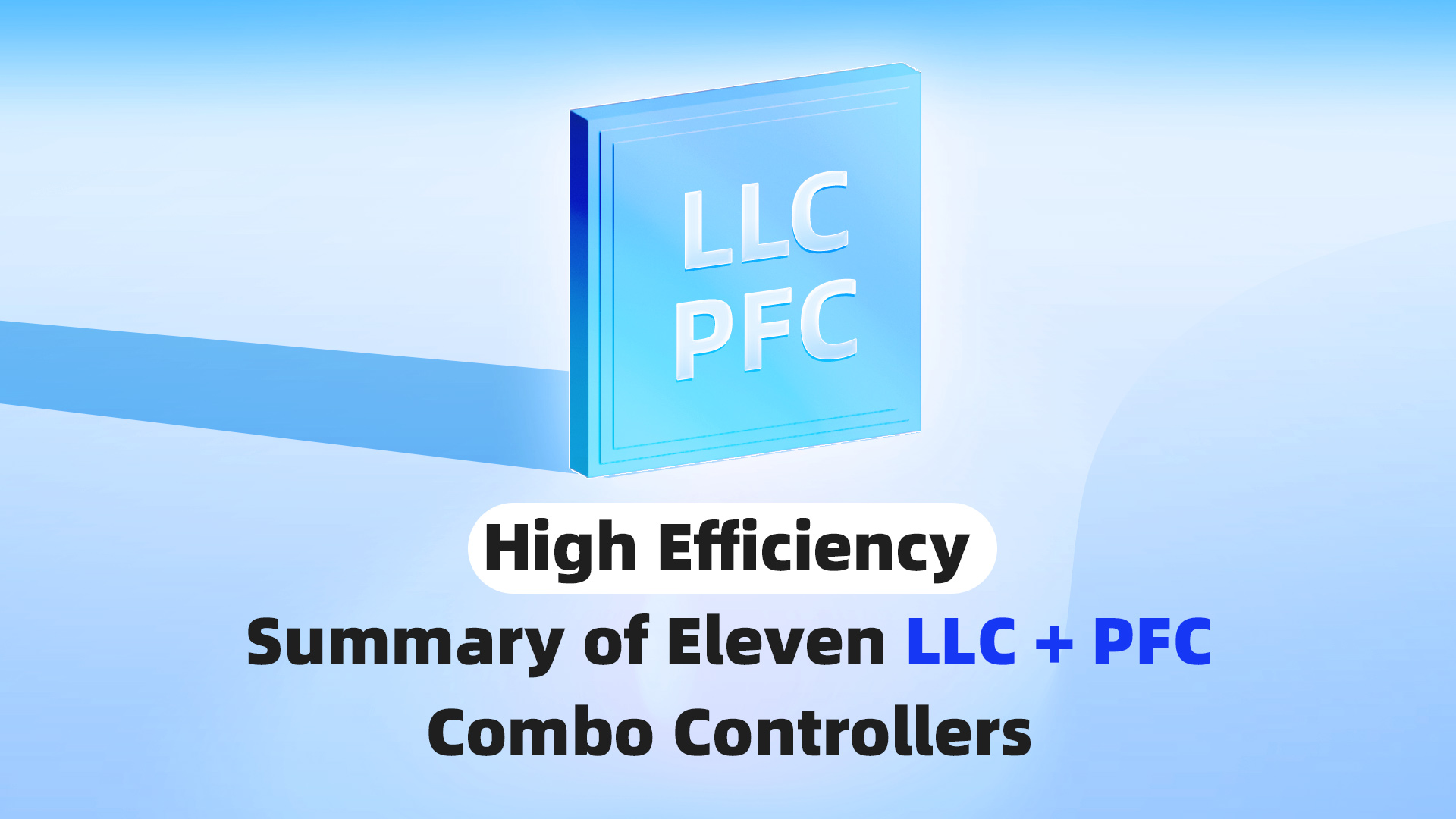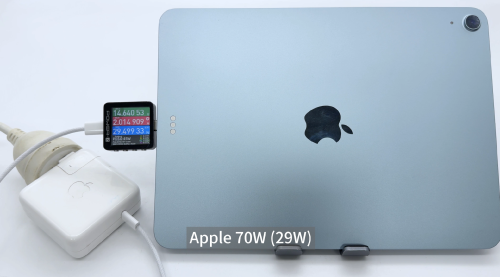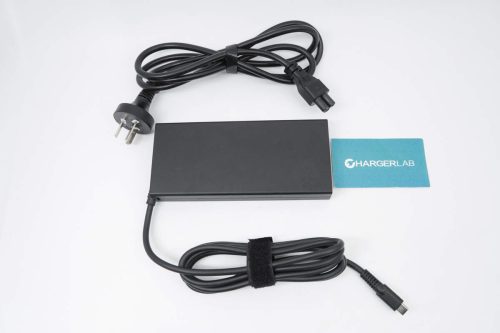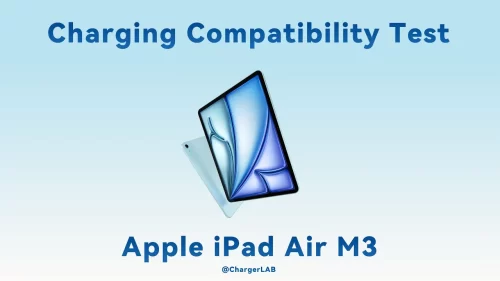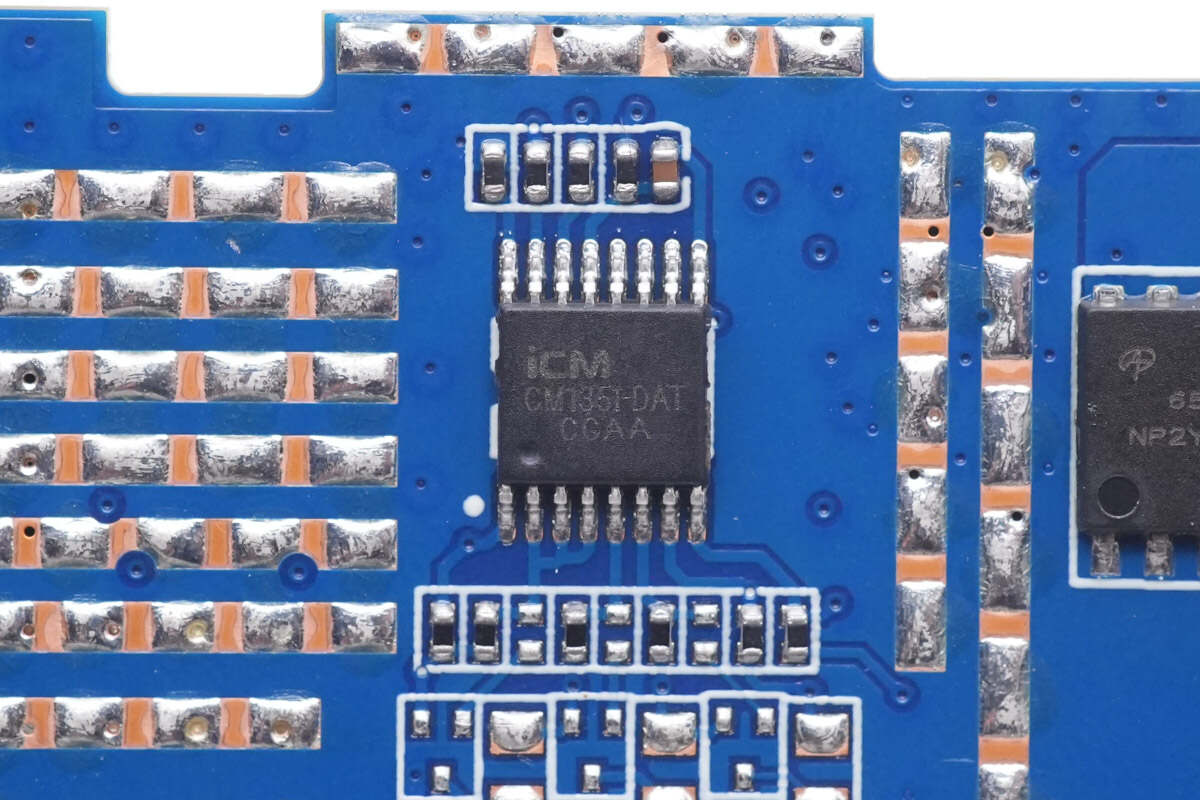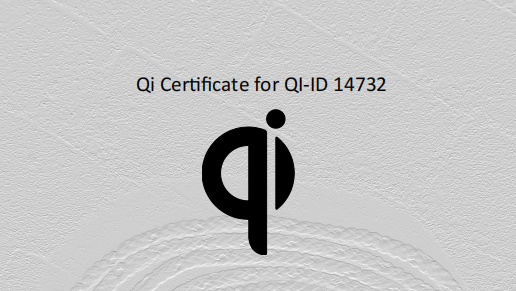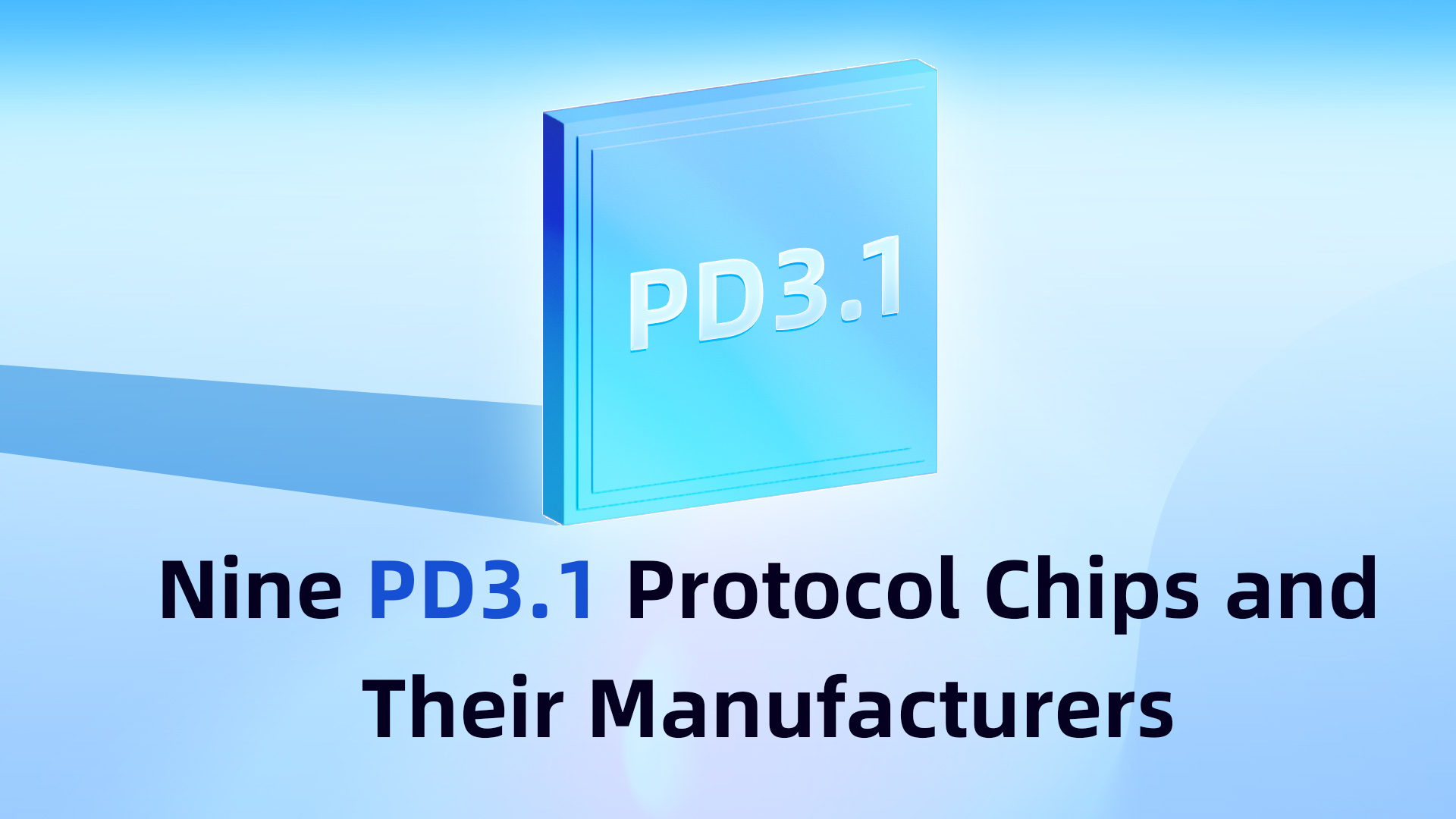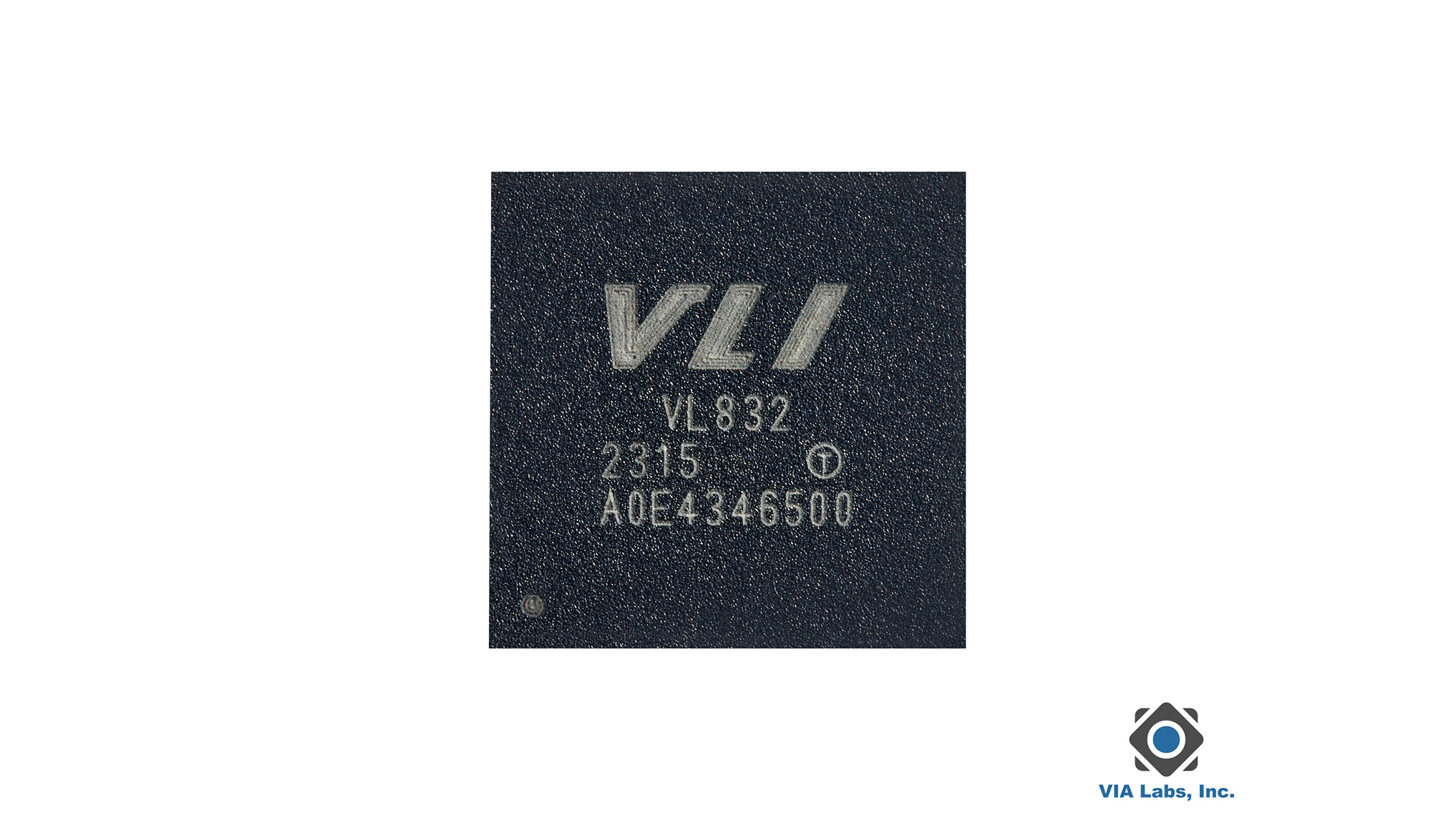Introduction
LLC topology, known for its high efficiency, has replaced traditional flyback circuits in many applications, achieving higher efficiency and lower energy consumption in household appliances. LLC topology is not only suitable for traditional household appliances with fixed voltage requirements but has gradually found use in high-performance, compact chargers like laptop adapters and PD fast chargers.
Due to the fixed input and output voltages required by LLC topology, and considering that applications using this topology are high-power sources, an additional PFC (Power Factor Correction) is needed for LLC. PFC not only corrects the power factor but also stabilizes the DC voltage supplied to the LLC. However, as demonstrated in some teardown videos, early chargers used separate PFC controllers and LLC controllers, leading to a higher component count.
As semiconductor technology has advanced, numerous manufacturers have introduced combined PFC and LLC controllers, integrating the functionalities of two chips into one, simplifying power supply designs. This integration reduces component count, allows PFC to dynamically adjust its working state based on the LLC load, achieving higher efficiency. Consequently, this integration has become the mainstream solution for high-performance power supplies in recent years.
Why LLC Needs to be Used with PFC
To understand why an LLC controller needs to be paired with PFC, it's essential to comprehend the LLC architecture. Simply put, the LLC architecture refers to a power circuit topology containing inductors (L), capacitors (C), and inductors (L) that achieve efficient DC-DC conversion through a resonant circuit formed by these components. The LLC architecture employs Zero-Voltage Switching (ZVS) soft switching technology, known for its high operating frequency, low losses, high efficiency, and compact size, thereby enhancing the power density of the charger. Its resonant operation allows soft-switching across the entire load range, minimizing switch losses, making it an ideal choice for high-frequency and high-power density designs, especially within a certain range of output voltages with improved EMI characteristics.
Since current after rectification in switch-mode power supplies often passes through large filtering capacitors, resulting in capacitive loads, it generates significant high-order harmonics, leading to pollution and interference. Hence, engineers began incorporating PFC circuits into switch-mode power supplies. Specifically, power supplies exceeding 75-85W are mandated to include PFC to improve power factor and correct load characteristics. PFC is divided into passive and active types. Passive PFC uses a large inductor for series compensation, but its main drawbacks include its large size and low efficiency.
With rapid advancements in semiconductor devices, active PFC has become mainstream. Active PFC utilizes a controller, MOSFET, inductor, and diode to form a boost circuit, known for its small size, wide input voltage, and excellent power factor correction effects. Active PFC achieves power factor correction based on the phase difference between voltage and current by driving the MOSFET to boost and rectify the main capacitor's charge.
Moreover, for LLC architecture to perform ideally, both input and output voltages must be fixed. The PFC circuit can stabilize rectified pulsating DC, supply power to the LLC, and perform power factor correction, meeting the working environment requirements of LLC architecture. In high-power-density adapters, the use of active PFC circuits in combination with LLC can reduce high-voltage filter capacitor sizes, reducing size and improving adapter power density.
PFC + LLC Combo Controller
ChargerLAB has compiled several popular PFC + LLC combo controllers available in the market, as listed below. Let's now delve into the parameters and features of each controller.
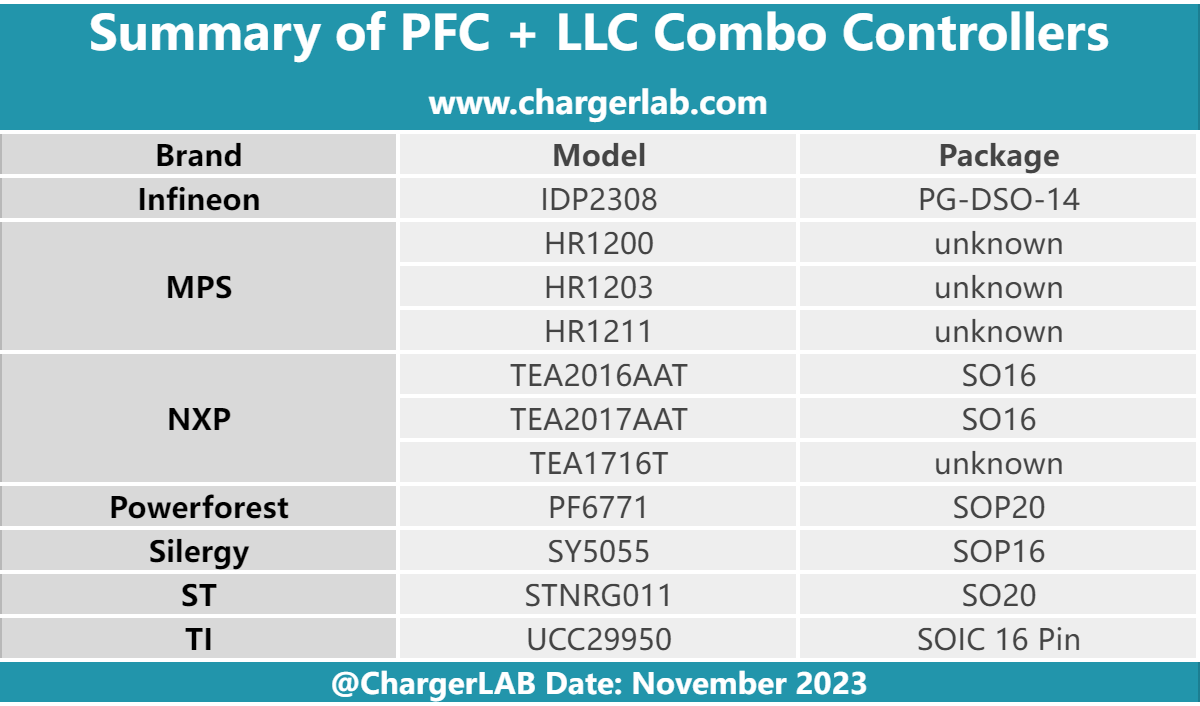
Infineon
IDP2308
The Infineon lDP2308 is a multi-mode PFC and LLC controller combined with a floating high side driver and a startup cell. Only a minimum of external components are required with the low pin count DSO-14 package. The integrated HV startup cell and advanced burst mode enable to achieve low stand-by power.
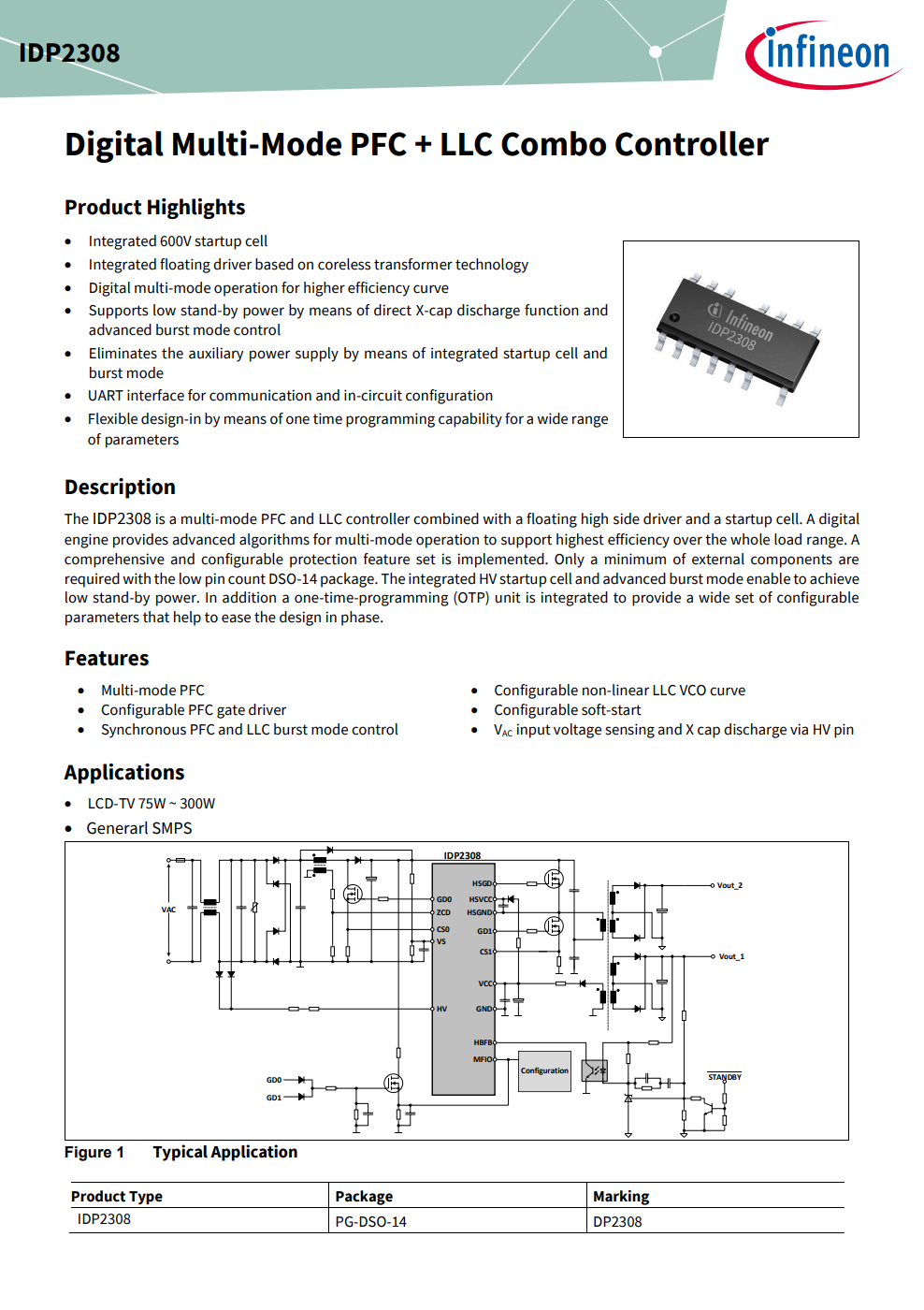
It also supports synchronous PFC and LLC burst mode control, with configurable PFC drivers supporting multiple modes. It boasts higher efficiency and power density, outperforming LLC+traditional MOSFET combinations. Additionally, it supports configurable protection functions, keeping peripheral components minimal.
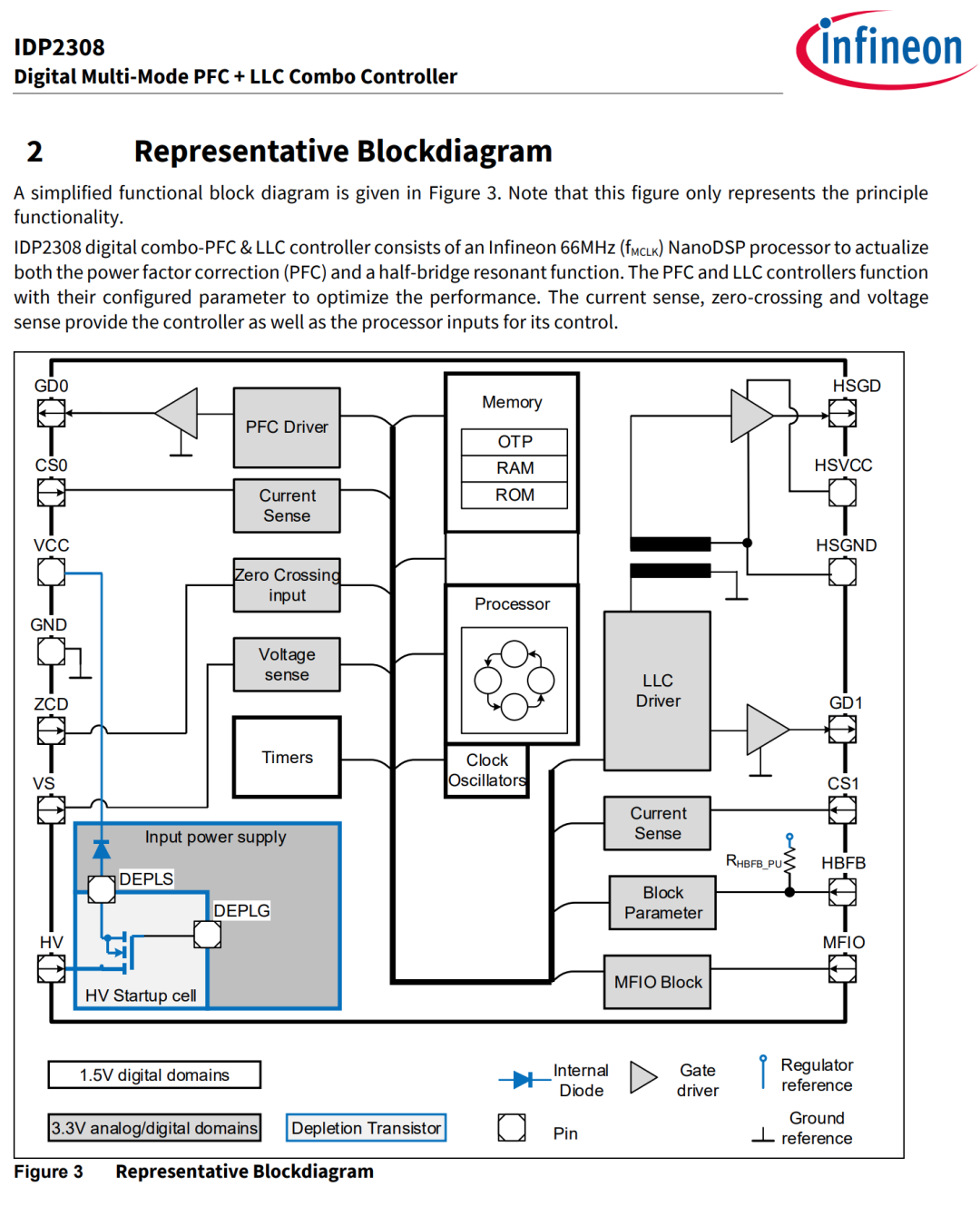
Infineon IDP2308's built-in processor allows programming via dpVision software through a half-duplex UART interface, configuring PFC and LLC parameters, and storing them in the built-in one-time programming memory.
MPS
HR1200
MPS HR1200 integrates a digital PFC controller and a half-bridge resonant controller. It requires very low power under no-load or ultra-light-load conditions, complying with the energy-using products (EuP) Lot 6 and 5th Edition's Tier 2 specifications.
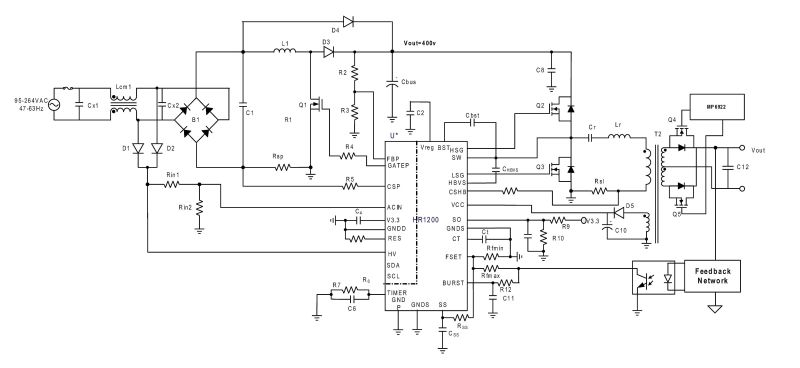
Its patented average current control scheme for PFC operates in continuous conduction mode (CCM) and discontinuous conduction mode (DCM) based on transient conditions of input voltage and output load. The IC exhibits excellent efficiency and high-power PF under light-load conditions. When operating in CCM, the controller can be used for applications up to 500W. The half-bridge LLC converter achieves high efficiency through zero-voltage switching (ZVS).
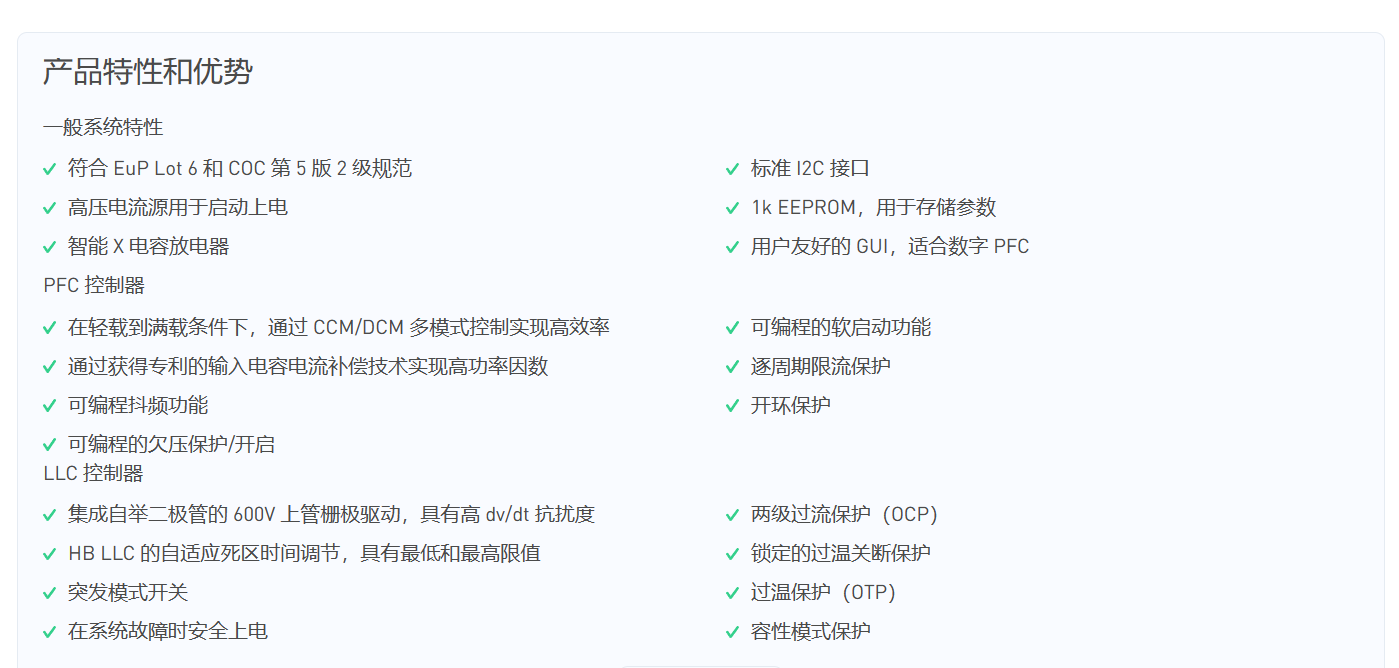
It also integrates a high-voltage current source within the IC for startup, eliminating the need for traditional startup resistors or external circuits.
HR1203
HR1203 is another high-performance controller integrating an advanced digital PFC controller and a half-bridge LLC resonant controller. Under no-load or ultra-light-load also meeting the energy-using products (EuP) Lot 6 and 5th Edition's Tier 2 specifications.
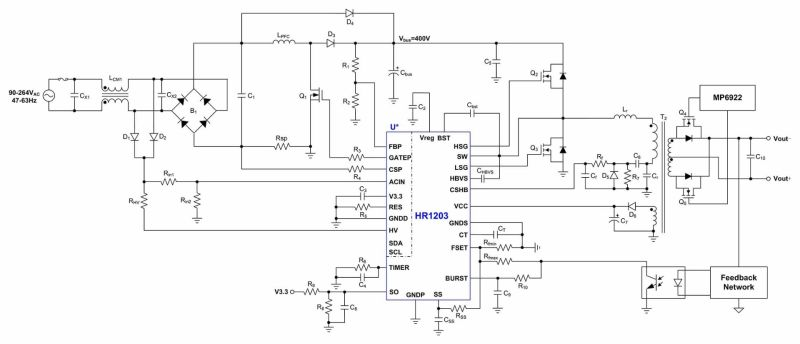
Its PFC uses an average current control scheme based on transient conditions of input voltage and output load, operating in continuous conduction mode (CCM) and discontinuous conduction mode (DCM). Additionally, the IC demonstrates excellent efficiency and high-power factor (PF) under light-load conditions.
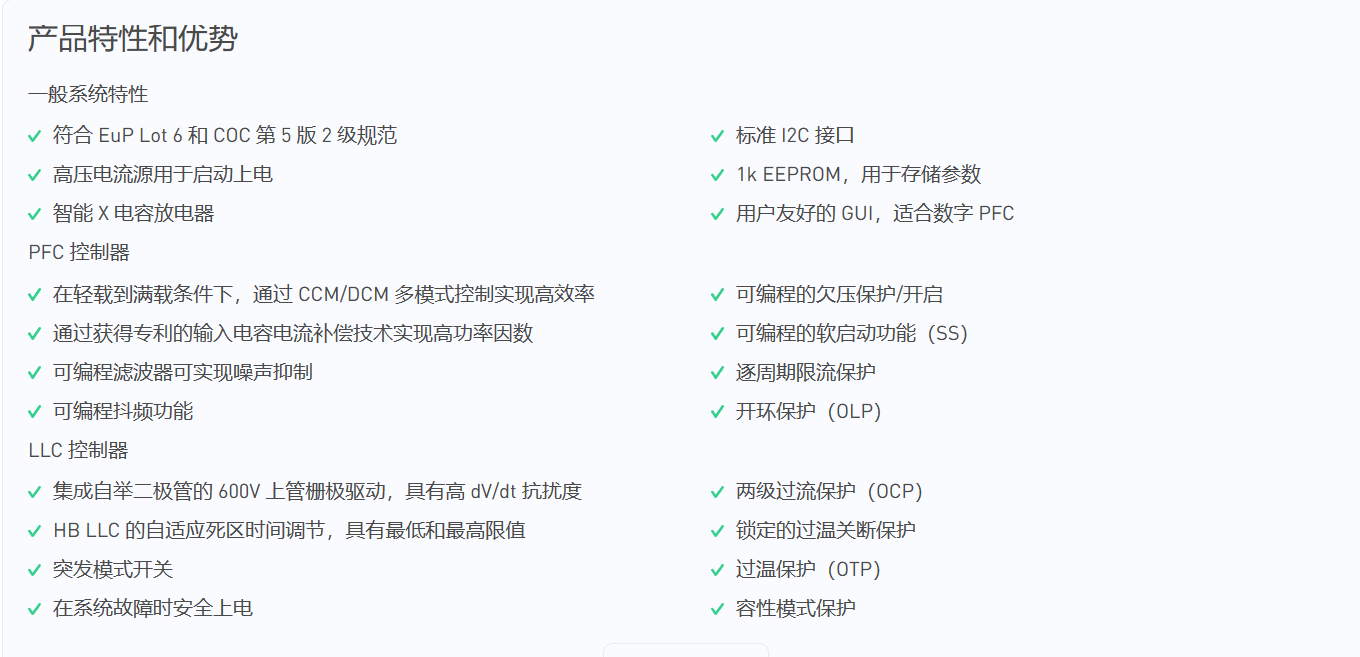
To enhance immunity to disturbances, HR1203 incorporates multiple programmable digital filters for critical signal filtering. Moreover, it features comprehensive protection functions, including over-temperature shutdown protection, open-circuit protection (OLP), over-current protection (OCP), over-voltage protection (OVP), and under-voltage protection/startup.
HR1211
MPS HR1211 is a multi-mode PFC and current-mode LLC integrated controller. Traditional chips would require 2-3 chips to achieve this function, resulting in significant differences in cost and sophistication. Notably, it can be programmed via UART interface. Its built-in energy-saving technology optimizes HR1211 efficiency across the entire operating range. Furthermore, it can operate in a hybrid CCM and DCM working mode.
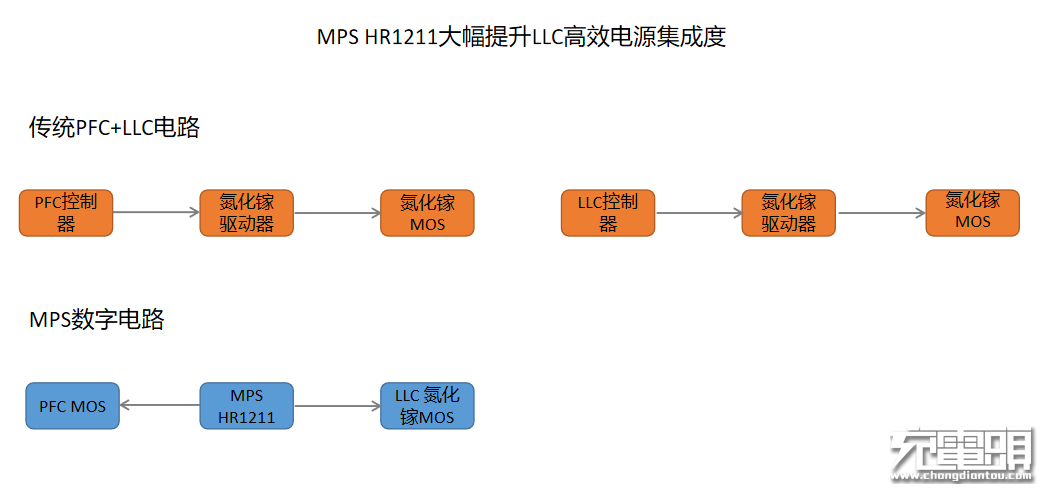
It integrates PFC and LLC controllers into a single package, similar to a Combo, enabling linked control based on load conditions for higher light-load efficiency.
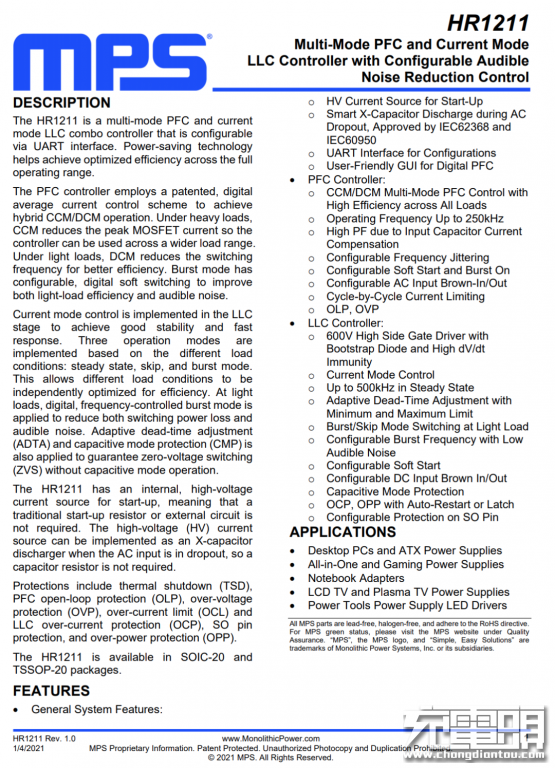
HR1211 employs a digital control scheme with multiple independent ADCs for detecting input voltage, PFC output voltage, LLC feedback voltage, and PFC peak switch current. It supports various comprehensive protection measures such as thermal shutdown, PFC open-loop protection, overvoltage protection, overcurrent limitation and protection, and over-power protection, among others. Notably, its standby power consumption is <100mW. Additionally, it supports high-voltage startup and intelligent X-cap discharge, with a PFC operating frequency of up to 250kHz.
NXP
TEA2016AAT
NXP TEA2016AAT comes in a thin and narrow SO16 package, integrating high-voltage startup, LLC, and PFC controllers along with their respective drivers.
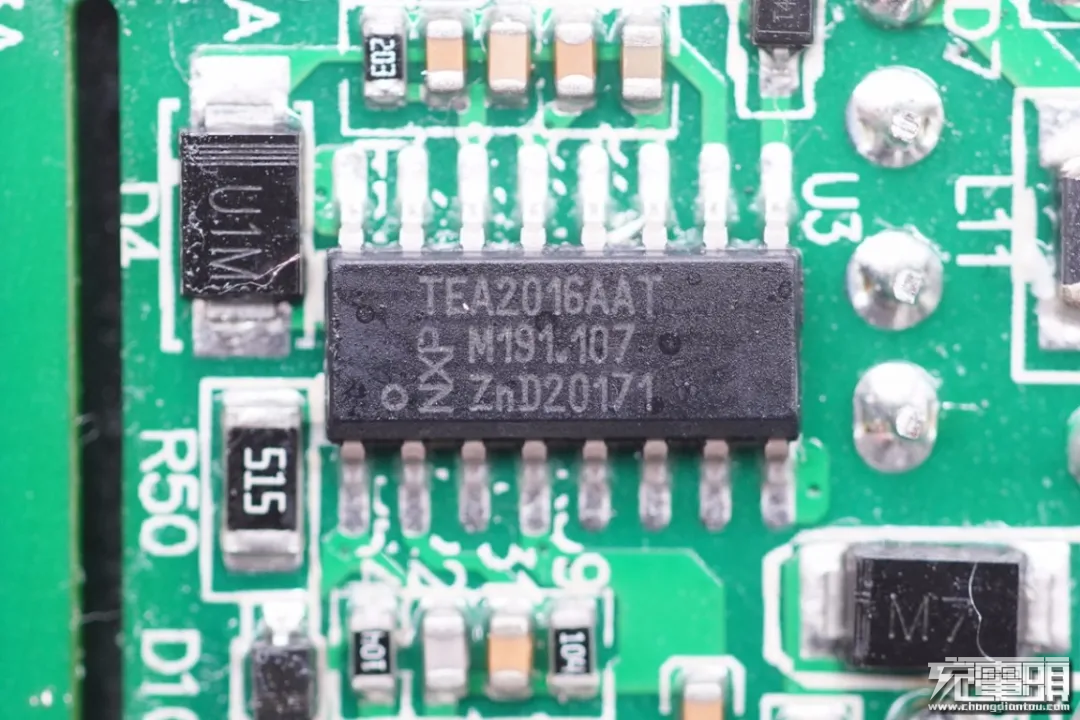
The chip employs valley/zero voltage switching to minimize switch losses, maintaining high conversion efficiency across the entire load range while meeting the latest energy-saving standards with standby input power <75mW. TEA2016AAT also features comprehensive protection functions including undervoltage protection, over-power protection, surge protection, and more.
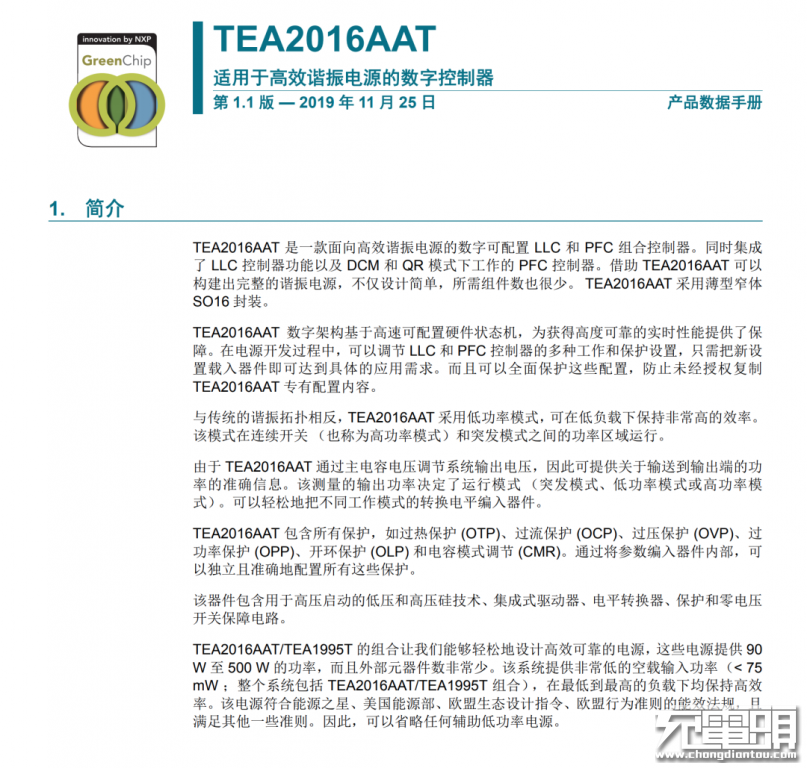
NXP TEA2016AAT is a digitally configurable LLC and PFC combination controller for efficient resonant power supplies. It integrates an LLC controller and PFC controllers operating in DCM and QR modes, enabling the construction of complete resonant power supplies. Furthermore, this chip adopts a digital architecture, allowing adjustments to LLC and PFC controller operation and protection settings during development.
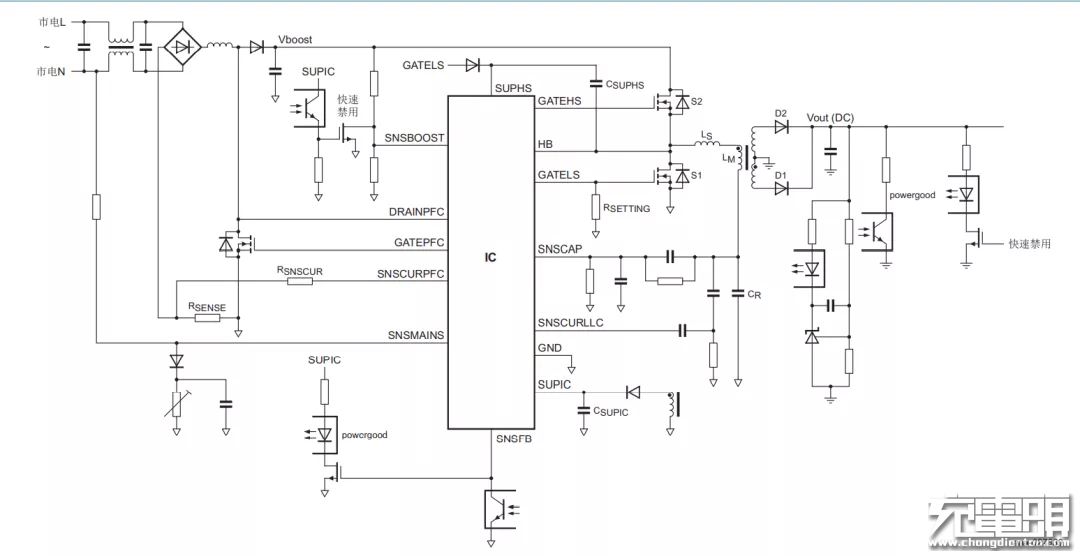
The combination of TEA2016AAT with TEA1995T easily achieves 90-500W power with minimal external components. This comprehensive system maintains very low standby input power (<75mW) across the entire load range and complies with energy efficiency regulations such as Energy Star, US Department of Energy, EU Eco-design Directive, and EU Code of Conduct.
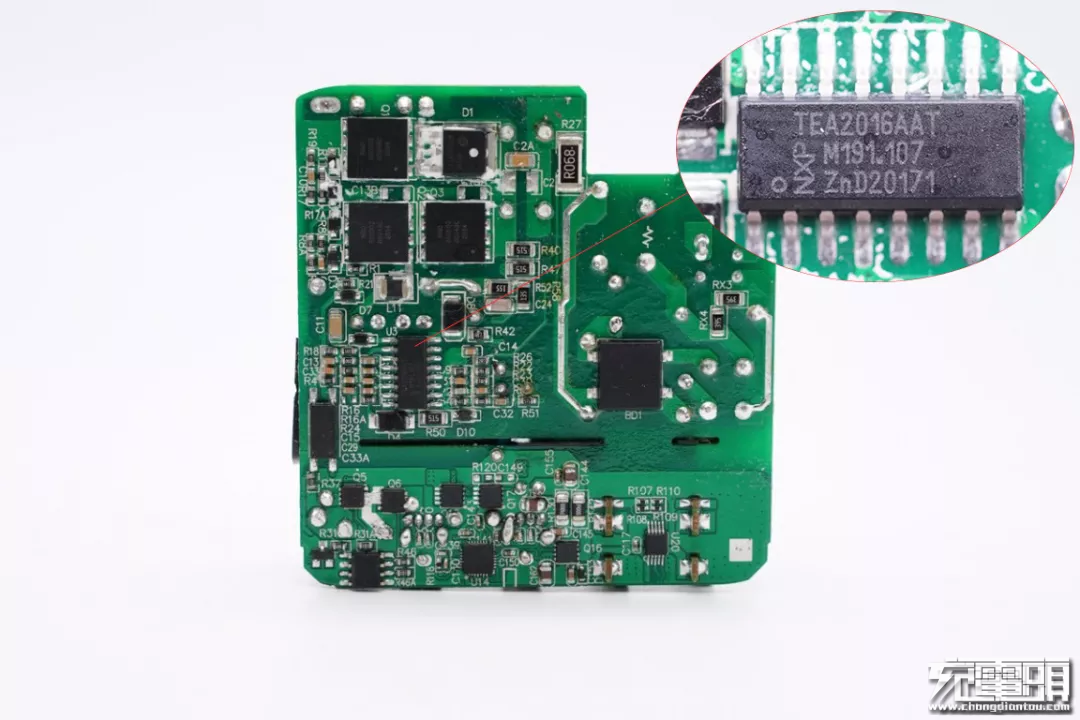
TEA2017AAT
NXP's latest TEA2017AAT is a digitally configurable multi-mode PFC+LLC integrated controller. Compared to TEA2016AAT, its PFC supports CCM operation mode.
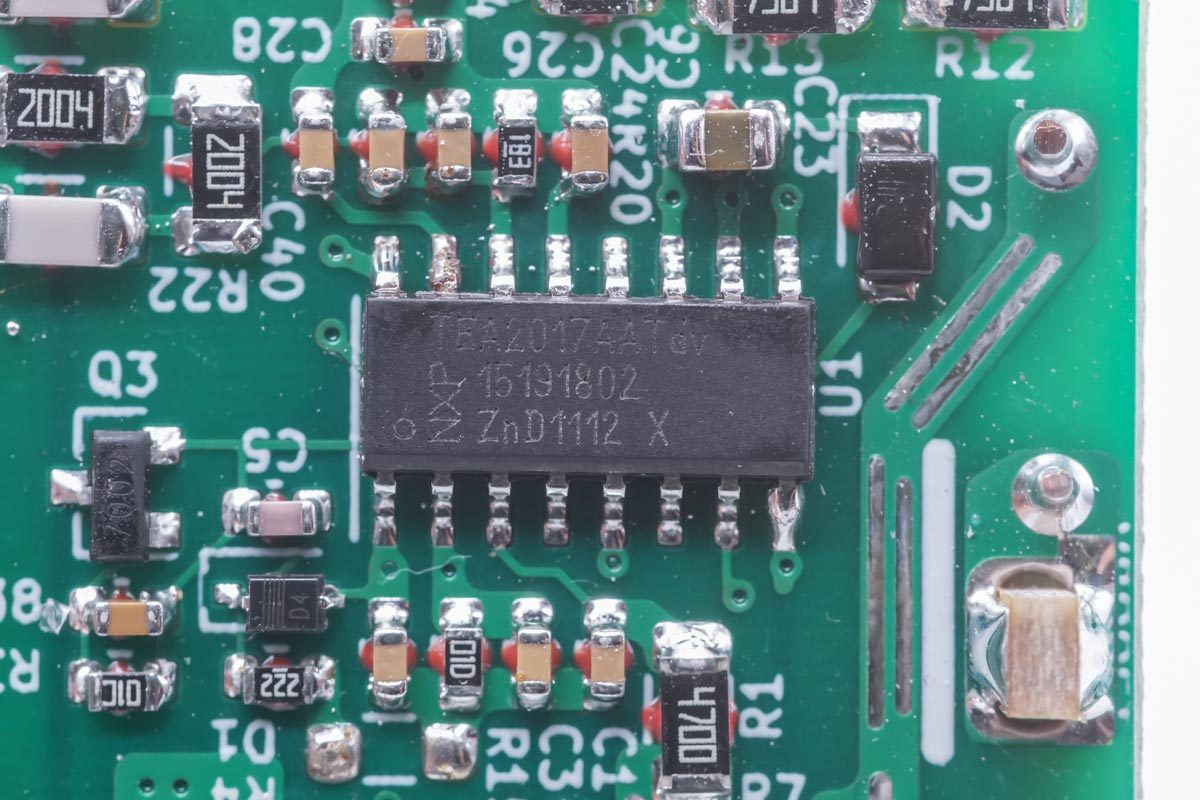
The configured PFC can operate in DCM/QR, CCM fixed frequency mode to optimize PFC efficiency, constructing a complete resonant power supply with simplified power design and minimal component count, housed in a narrow body-width SO16 package.
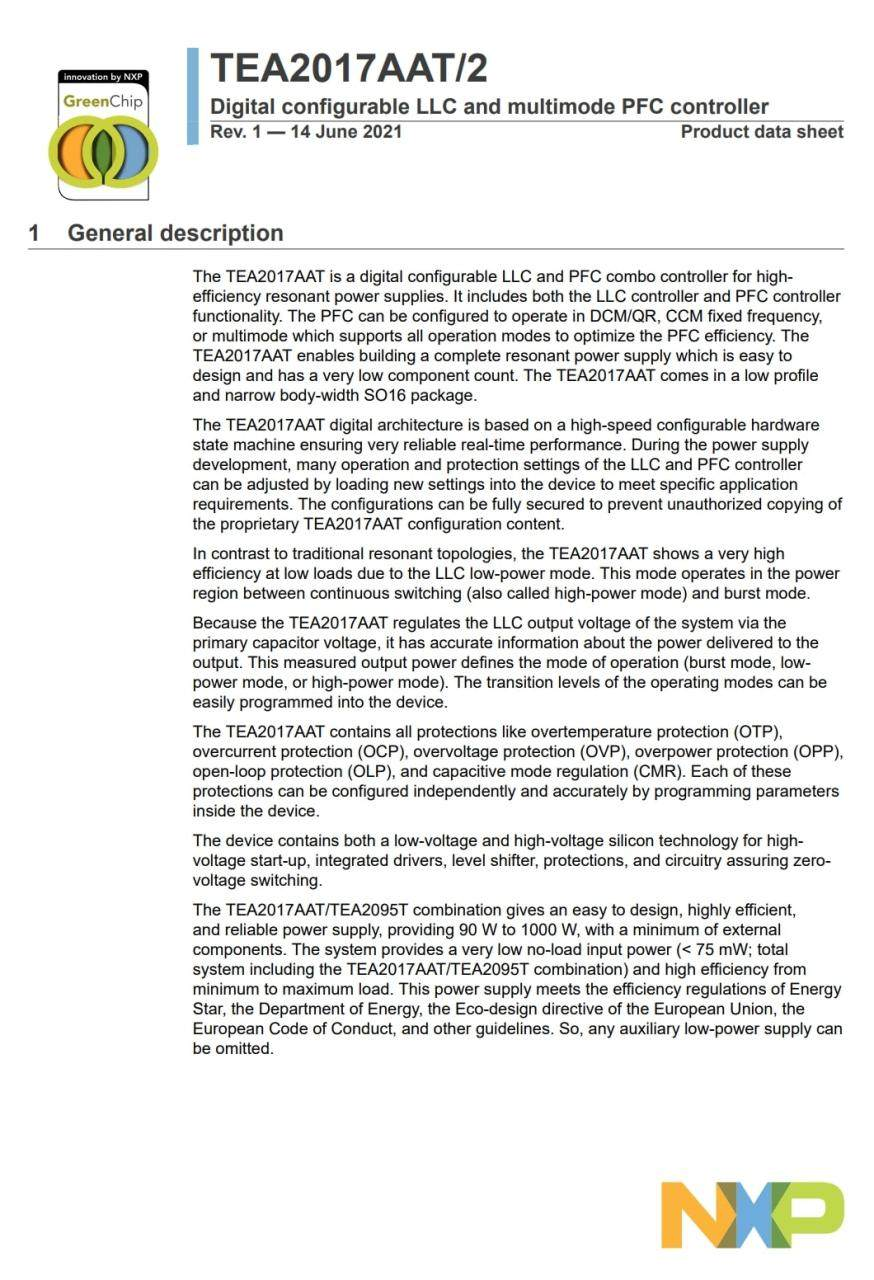
Its digital architecture is based on a high-speed confiqurable hardware state machine ensuring very reliable real-time performance. And the configurations can be fully secured to prevent unauthorized copying of the proprietary TEA2017AAT configuration content.
In contrast to traditional resonant topologies, the TEA2017AAT shows a very high
efficiency at low loads due to the LLC low-power mode. This mode operates in the power region between continuous switching (also called high-power mode) and burst mode.
TEA1716T
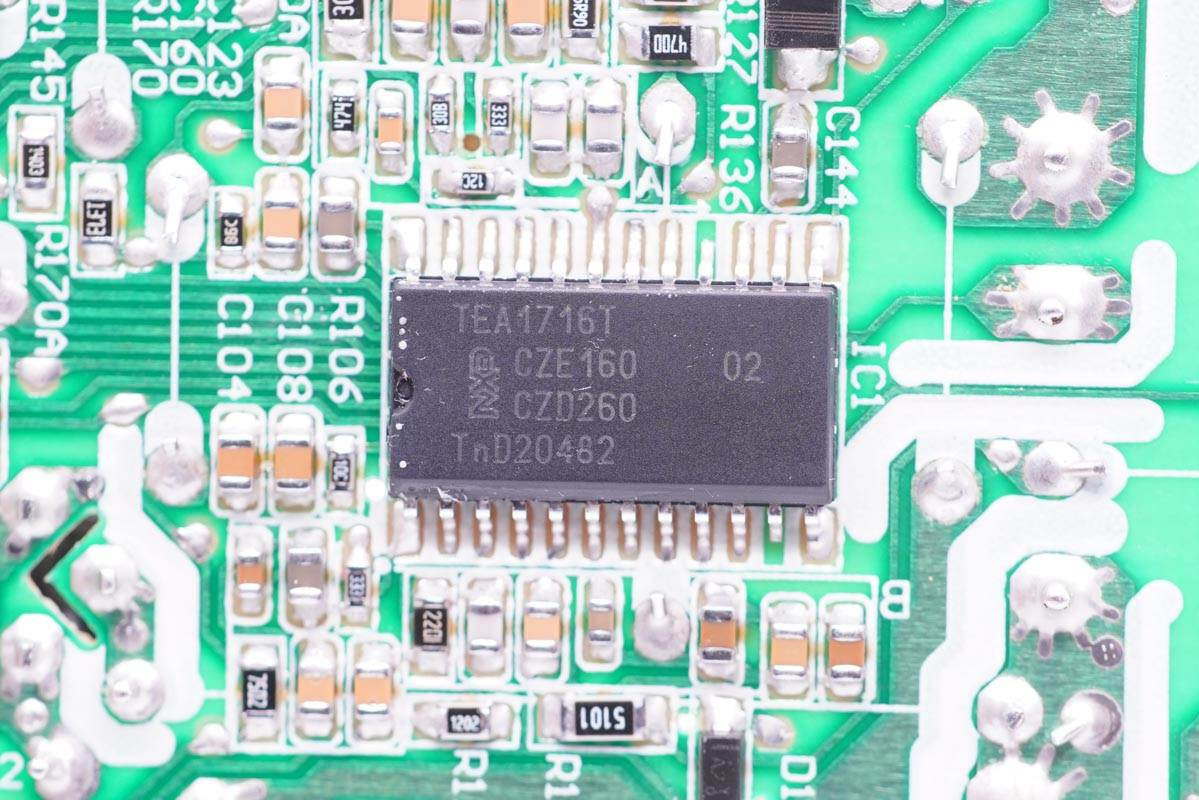
NXP TEA1716T is an integrated half-bridge LLC+boost PFC combination controller featuring intermittent frequency operation mode, compliant with EuP lot 6, suitable for LCD TVs, laptop adapters, desktops, and all-in-one power supplies.
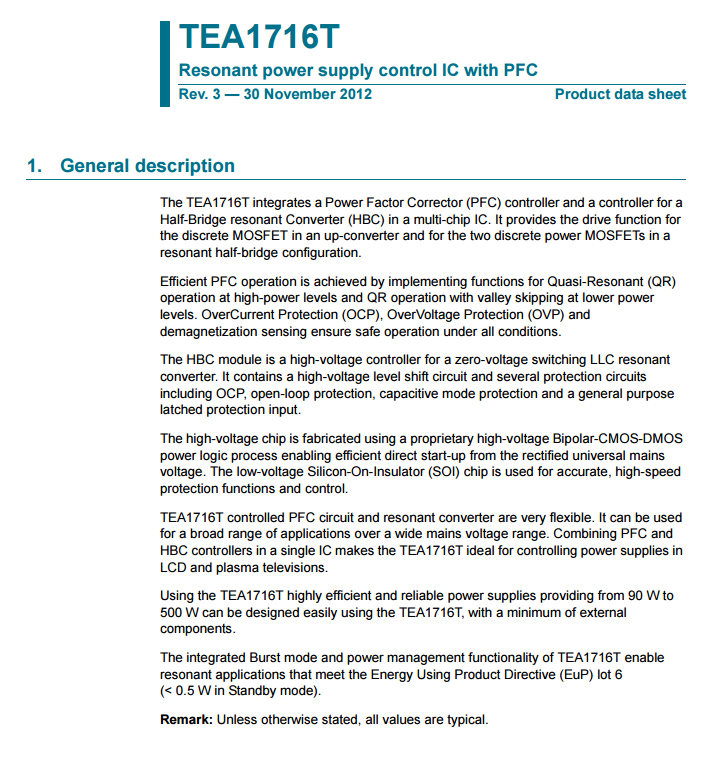
Here is all the information about it.
Powerforest
PF6771
Next is Powerforest's PF6771, a PFC and dual-feedback LLC integrated digital controller capable of outstanding performance and powerful features, meeting the needs of applications with two fixed outputs below 250W.
In the dual-feedback LLC architecture, NMOS and PMOS correspond to different outputs; for instance, in a TV system, PMOS corresponds to the system's 12V/5A switch, while NMOS is the backlight 130V/1A switch. Through their duty cycle ratio variation, PF6771 meets the wattage requirements of two different outputs, reducing efficiency losses in the primary backlight boost and additional power components, enhancing efficiency, and saving costs.
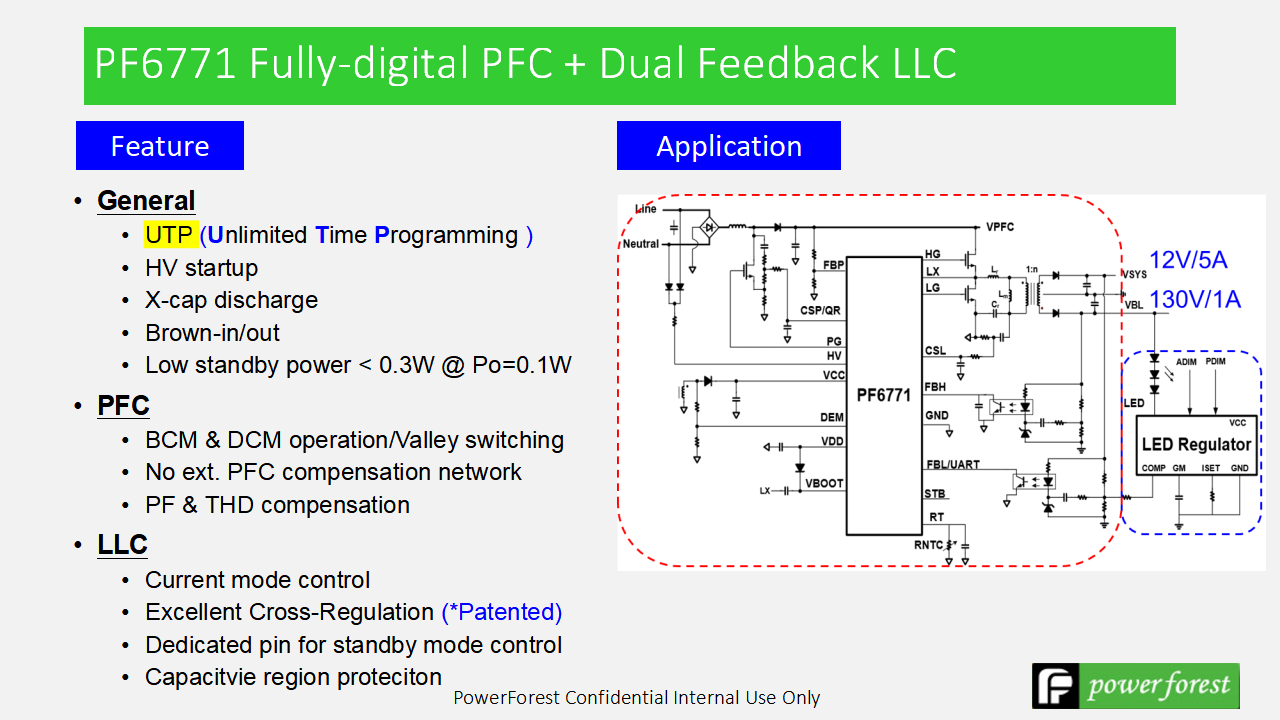
Its PFC operates in BCM mode and employs digital compensation design without external PFC compensation networks, effectively compensating for power factor and harmonic distortion. The LLC adopts current-mode control. Additionally, it has dedicated pins for standby mode control, providing flexibility and control options.
Silergy
SY5055
Silergy SY5055 is a highly integrated PFC and LLC combined controller, consolidating the functions of separate PFC and LLC devices, reducing component count and simplifying design.
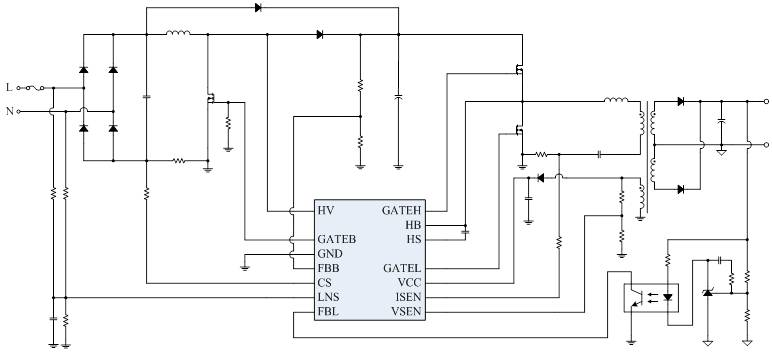
With a single chip, SY5055 provides PFC and LLC control signals simultaneously.
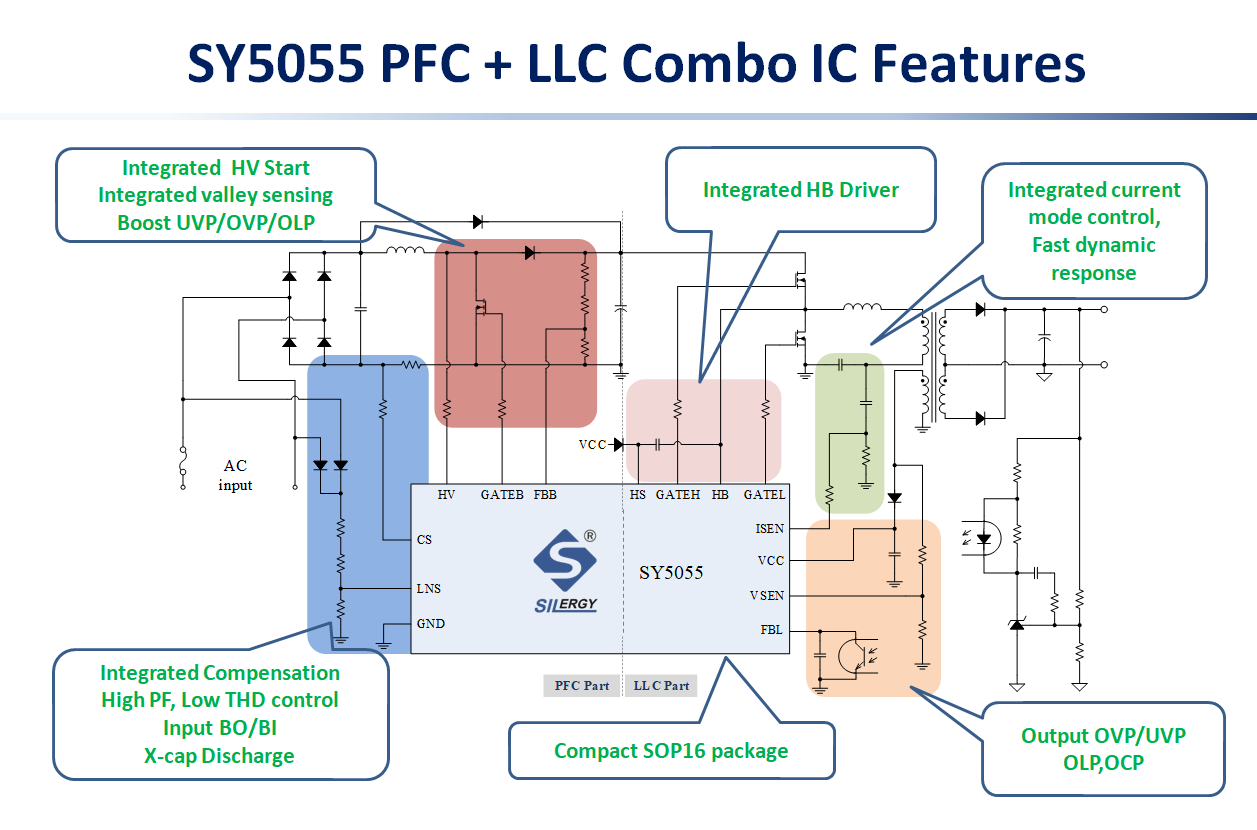
SY5055 supports high-voltage startup, integrates valley detection, offers PFC undervoltage, overvoltage, overload protection, supports X-cap discharge, and features compact SOP16 package with various output protections.
ST
STNRG011
STMicroelectronics' STNRG011 is a digital multi-mode PFC+time shift LLC controller, featuring an integrated 800V high-voltage startup circuit, input voltage detection, and X-cap discharge function to reduce standby power consumption. Its built-in PFC controller supports input voltage feedforward, THD optimization, and frequency limitation, operating in enhanced fixed off-time mode.
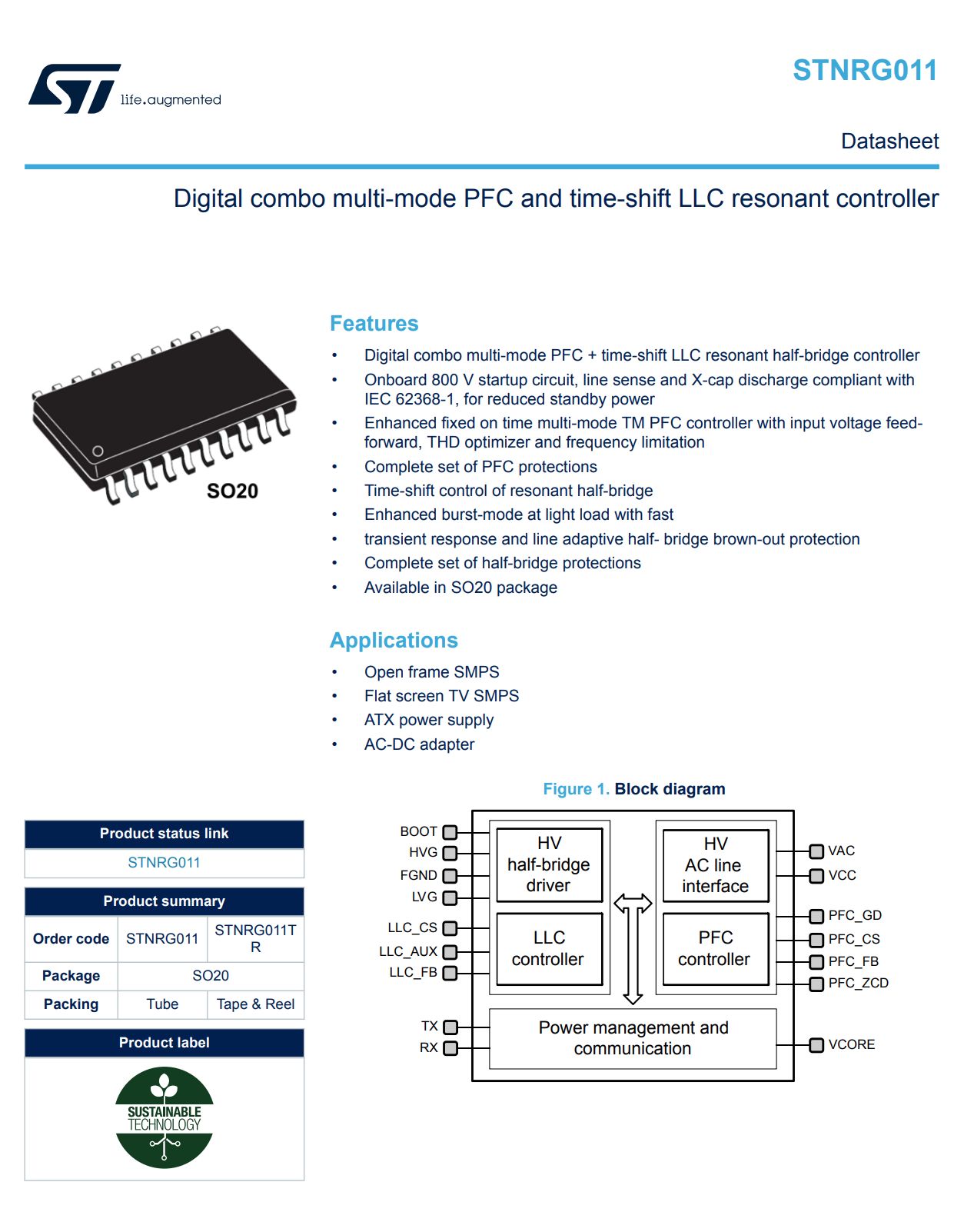
It offers a complete set of PFC protection, convenient timing control for resonant half-bridge, enhanced burst mode for quick bursts, and a comprehensive half-bridge protection function. It can be used in open-frame power supplies, flat-panel TV power supplies, PC power supplies, and adapter applications.
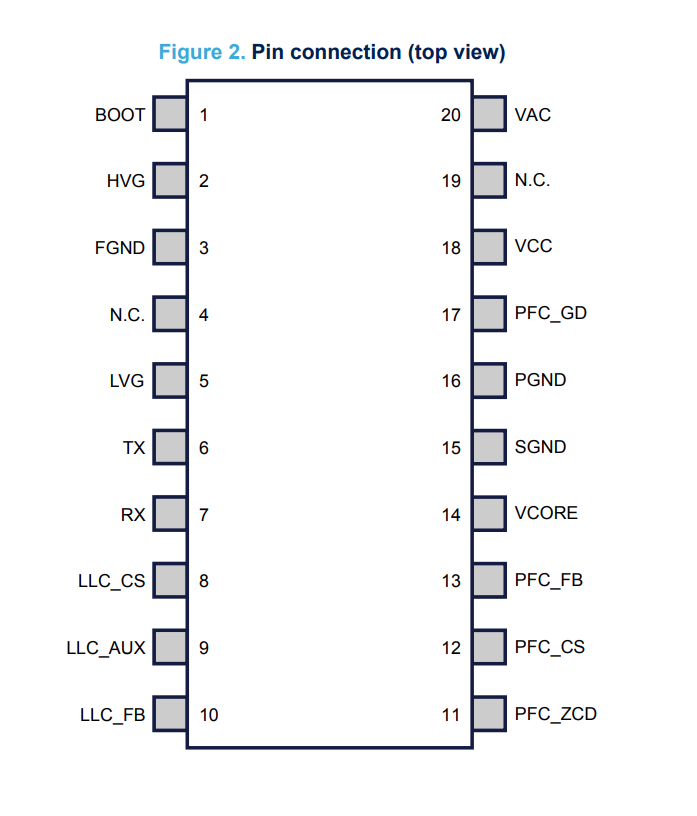
STNRG011 uses an SO20 package with a block-oriented pin design that separates high-voltage and drive pins from sampling pins, facilitating circuit optimization. It features an 8-bit digital core control, digital algorithms, and hardware simulation circuits. The chip has built-in ROM memory for algorithm storage and supports UART pin communication for monitoring functions.
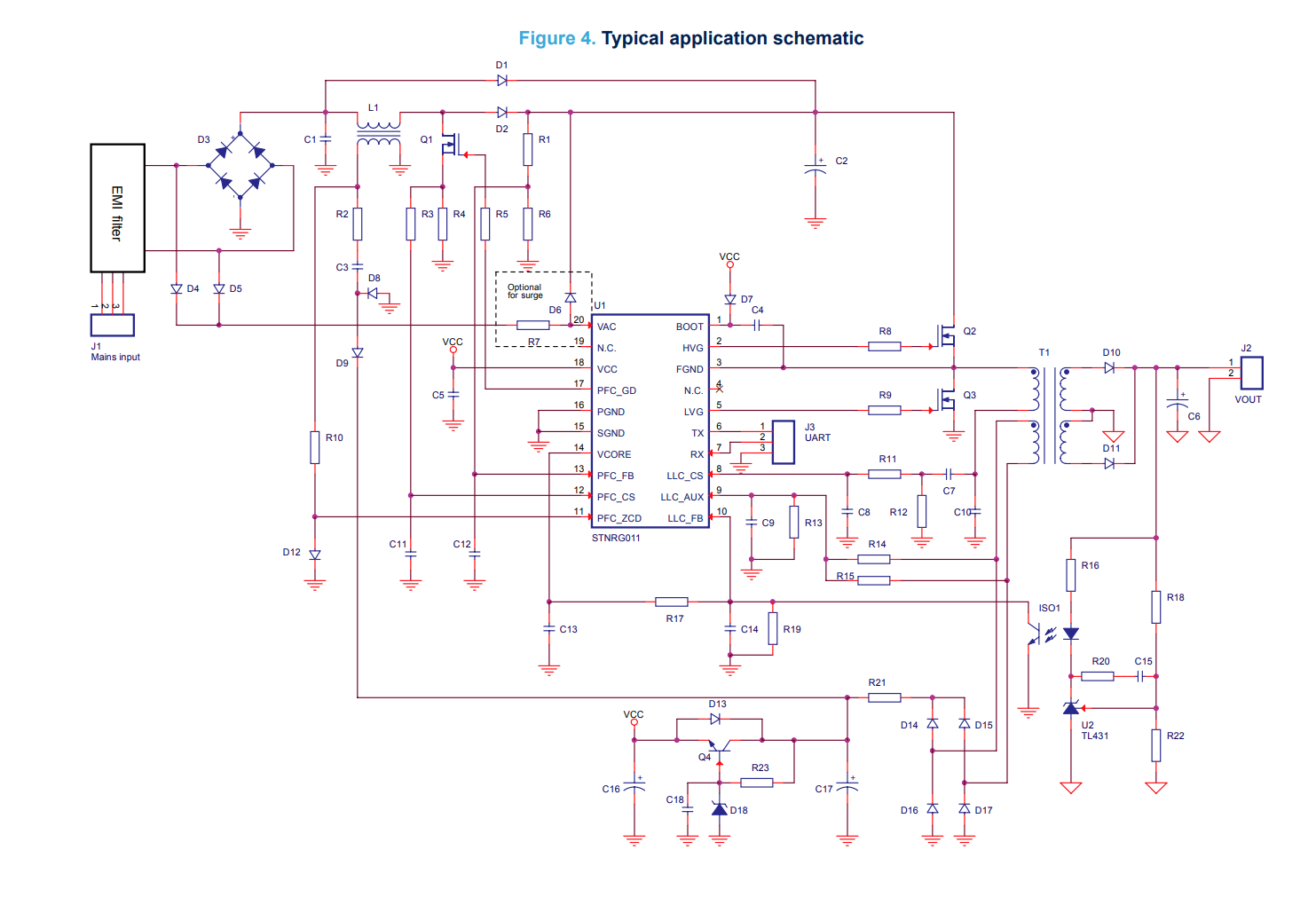
This is the application circuit diagram for STNRG011, where a single chip achieves complete PFC+LLC control. The chip is controlled by a digital core, and multiple key parameters are programmable. It features comprehensive built-in protection functions and supports configuration protection through the chip's internal memory. The inclusion of the digital core significantly reduces the difficulty of power supply development and debugging.
TI
UCC29950
TI UCC29950 is a PFC and LLC combined controller that provides comprehensive control functions for AC-to-DC converters with CCM boost power factor correction (PFC) and LLC transformers. The controller is optimized for ease of use. Its proprietary CCM PFC algorithm enables the system to achieve high efficiency, smaller converter size, and high power factor.
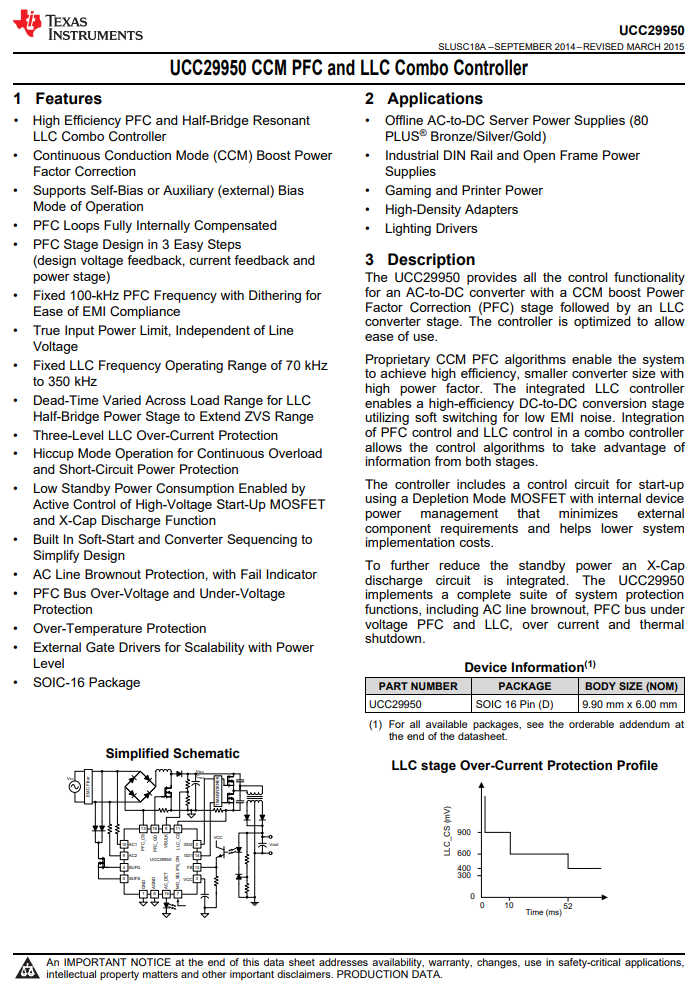
It includes a startup control circuit using an internally powered MOSFET in depletion mode to minimize external component requirements and help reduce system implementation costs. To further reduce standby power consumption, it integrates an X-cap discharge circuit. It features a complete set of system protection functions, including AC line dropout, PFC bus undervoltage, PFC and LLC overcurrent, and thermal shutdown.
Summary of ChargerLAB
The development of PFC + LLC combo controllers represents a significant advancement in power electronics technology. Not only does it reduce circuit complexity, but it also enhances system efficiency and performance. This type of controller has a wide range of applications, covering various power supply needs from electronic devices to industrial fields, providing feasible solutions for achieving more efficient and reliable power conversion.
With the widespread application of high-power PD fast charging, the market will continue to evolve. Meanwhile, major manufacturers will continually seek innovation and competitive advantages to meet the growing user demands and strive for larger market shares in this rapidly changing market. This will bring more choices and more efficient solutions for consumers. Let's eagerly anticipate these developments!
Related Articles:
1. Global Debut of NuVolta Qi2 MPP Module
2. For iPhone 15 | ConvenientPower Launches Three Qi2 MPP Wireless Charging Modules
3. Forward Thinking | 9 Qi2 Wireless Charging Chips by 6 Leading Manufacturers

